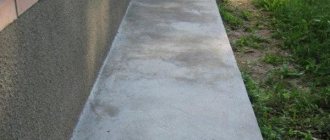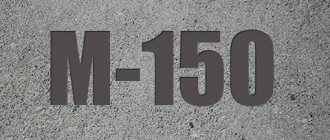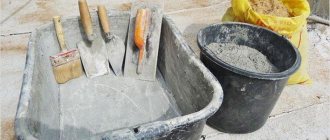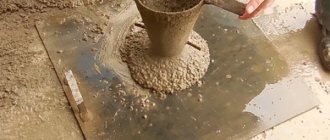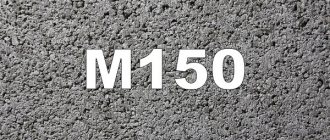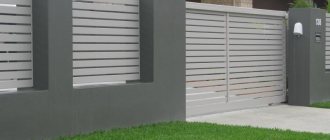Step-by-step instructions for making concrete by hand
Nowadays, concrete mixers are most often used for concreting. But not all developers yet work with technology, especially if they need to quickly prepare a small amount of concrete for urgent repairs. The mass is stirred with a shovel or hoe in a special trough. If you don’t have it, then you can make concrete on a hard, level area; large sheets of thick iron are often used for this purpose. Mixing is much simpler and easier with a hoe; attach a long handle to it so that you can reach from one place throughout the entire trough.
Trough and hoe for mixing concrete manually
Step 1. Fill a container with dry cement, pour in water and mix everything very thoroughly. Your task is to turn the composition into the consistency of milk. A bucket of cement requires about half a bucket of water. Below we will describe in detail what causes this proportion.
Cement is poured into a dry trough, then water is poured in.
Step 2. Mix the composition thoroughly with a hoe.
Cement and water must be mixed until the lumps dissolve
In such a container you can prepare a composition from one bucket of cement, three buckets of sand and the same amount of crushed stone. There is no need to do more at one time - it is very difficult to mix increased volumes of concrete. It's much easier to make two small batches than one big one. In addition, the quality is also much better, the positive effect is achieved through more thorough mixing.
Step 3. Pour crushed stone into the trough. It will completely break up the remaining small lumps of cement. You can pour all three buckets of material at once; it is advisable to distribute it evenly over the entire area of the container.
Crushed stone can be added immediately in full
Step 4: Start mixing. This is already somewhat more difficult than working with cement alone.
Stirring with crushed stone will require more physical effort
Step 5. Add three buckets of sand to the container. In our case, sand and crushed stone are poured into bags, each containing three buckets, as required by the recipe. Mix the sand, this is the most difficult operation and requires quite a lot of effort and time. The hoe should slide along the bottom of the trough and across the entire area.
After adding sand, you need to stir very thoroughly.
Depending on the actual consistency, add water or sand; we have already described how this is done and what you need to pay attention to. Prepare as much mixture as you can use within thirty minutes
After this time, the rates of chemical reactions of cement critically increase. Concrete hardens; adding water to it is strictly not recommended; as a result of such actions, the material significantly worsens its strength parameters.
Ready concrete must be used within half an hour
Purchasing components for concrete from Bauff
If you have not figured out how much cement, crushed stone or sand is required to mix high-quality concrete, then the company’s managers can provide appropriate technical consultation. It is enough to submit a request for the selected product, or call us directly to discuss the details of the order. Service is provided throughout Moscow and the Moscow region on individual terms.
We will do everything possible to ensure that you receive the optimal batch of products, paying for it in a convenient way in the shortest possible time. All warranty obligations will be respected unconditionally. As a result, you will receive high-quality products from leading manufacturers. Leave your own reviews that will help improve the service and range of Bauff. We wish you success!
Calculation of concrete mixture composition
The classification of concrete is based on compressive strength. In accordance with the requirements of SNiP2.03.01-84 “Concrete and reinforced concrete structures”, the marking of concrete on concrete structures, as well as from a mixture of sand and crushed stone, contains the letter “B” and numbers indicating the load in MPa. This is a relatively new designation.
The more familiar marking with the letter “M” and strength, measured in kg/cm2, has not lost its relevance. By the way, cement is marked in exactly the same way. Concrete grades from M100 to M 500 are used in construction.
The strength, density and other characteristics of the final product are affected by the ratio of cement and the proportion of PGS in concrete, as well as the content of aggregates made from grains of different sizes in the mixture. The following grades of concrete are used for certain purposes:
- M 150 – it is recommended to prepare for the construction of foundations for light buildings of one floor;
- M 200 – used in the construction of strip and low-power slab foundations;
- M 250 – for foundations in the form of a monolithic slab for medium loads;
- M 300 – for monolithic foundations of any design;
- M 400 - with high-quality cement, used for the construction of especially powerful foundations under heavy loads.
For the convenience of calculating material consumption, we will combine the proportions of pgs and cement for concrete of different grades into a table.
| Concrete grade | Consumption of OPGS per 1 kg of Portland cement, kg | Consumption of OPGS per 10 liters of Portland cement, l | Amount of concrete produced from 10 liters of cement, l | |||
| M 400 | M 500 | M400 | M500 | M400 | M500 | |
| 100 | 11,6 | 13,9 | 102 | 124 | 78 | 90 |
| 150 | 9,2 | 11,1 | 82 | 98 | 64 | 73 |
| 200 | 7,6 | 9,1 | 67 | 81 | 54 | 62 |
| 250 | 6,0 | 7,1 | 53 | 63 | 43 | 50 |
| 300 | 5,6 | 6,7 | 49 | 59 | 41 | 47 |
| 400 | 3,9 | 4,8 | 35 | 42 | 31 | 36 |
| 500 | 3,6 | 4,3 | 32 | 37 | 29 | 32 |
According to the table, you can understand that from 10 liters of M400 cement you can get 41 liters of M 300 concrete. If you measure proportions in buckets, then to prepare concrete you need to measure out one bucket of cement and almost 7 buckets of sand and gravel mixture.
Using the available proportions, you can easily calculate the need for materials to prepare 1 m3 of concrete. Let's make simple equations:
- You will need M400 cement: 1000 * 10:41 = 244 liters or 24.5 buckets.
- ASG for 1 cubic meter of concrete should be taken: 1000 * 49:41 = 1195 liters or 119.5 buckets.
Requirement for crushed stone per cubic meter of concrete solution
When trying to determine the mass and volumetric value of crushed stone per cubic meter of concrete, study the popular batch recipe. In addition to the filler, it will indicate the content of other ingredients and water. Perhaps one of the easiest ways is to use an online calculator, which will answer the question in a matter of seconds. You just need to enter the initial data.
Often the ratio of crushed stone to a cubic meter of concrete is approximately 0.8. This is true provided that the structural support is not subject to excessive load. In general, for a standard crushed stone size of 20 mm and a density of 1400 kg/cubic meter, the consumed mass value will be about 1200 kg. The remaining ingredients will fill the voids, securely holding the solution together. If the granularity of the placers is calculated ideally, then this rule will fully correspond to the parameterization of the prepared solution.
An approximate table of ratios for concrete of different brands is presented below. The basis is M400 cement powder.
When calculating the content of crushed stone, you can use a variety of formulas. Their complexity can confuse the average novice master. If you pay attention to the previously mentioned calculators, then they programmatically implement all the algorithms that specialized Internet resources can offer. We strongly recommend that you read our articles in order to effectively select ingredients for the solutions you create, and then buy suitable building materials on favorable terms.
A simple calculation option in practice
The approximate weight of a cubic meter of concrete is 1700-2500 kg. The final value depends on the parametric features of the ingredients of the mixed solution. A rough recipe looks like this:
- 200-400 kg of cement;
- 500-700 kg of sand;
- 1100-1300 kg of crushed stone;
- 100-200 liters of liquid.
In the conditions of private development, all these “norms” are often neglected, taking by eye the volumetric value of crushed stone, approximately equal to that which is relevant for the entire solution. After all, the binding powder and sand fill the voids between the stone crushing, and not vice versa.
Experimental formula calculations
There is a real calculation formula for crushed stone that allows you to calculate the need for it.
Ш = 1000 / (a*V voids area / y filled area + 1 y area), where
- a – expansion coefficient;
- V voids – void mass value;
- y embankment – bulk mass value;
- y – density.
Important! All values except the multiplier a are given in units of kg/l.
So, for example, for a mortar of the 200th grade, cement powder of the 400th grade and a filler with a density of 2.5 kg/l, a 20-mm size, a bulk and hollow mass value of 1.3 kg/l and 0, are taken. 49 kg/l respectively. The calculation yields a value of 1227 kg/cubic meter. In general, this result is fully consistent with the above “folk” norm.
Materials calculation: without reinventing the wheel
How to calculate cement for the foundation? For the accuracy of the results, it is necessary to take into account the grades of concrete and cement, as well as the ratio of water and cement, which is called briefly - VC. The table below is visual and does not require a person to have a degree in mathematics.
The table is easy to use. For example, we need to prepare 2 m3 of M250 concrete:
- It requires M500 cement, which means we multiply 297 kg by 2 and get 594 kg. Now this number must be divided by 50, since this is the weight of one bag of cement: 594/50 = 11.88. We round the result towards a larger value - we get 12 bags of M500 cement.
- Crushed stone with a grain size of 20 mm for our concrete will be calculated as follows: 1188 multiplied by 2, we get 2376 kg. If you choose a different faction, then all calculations will have to be done again.
- Sand is calculated in the same way as crushed stone: 1188 * 2 = 2376 kg.
- We find water like this: multiply 205 liters by 2, resulting in 410 liters.
Indeed, calculations should not cause difficulties; you just need to decide on the required characteristics of your raw materials. If plasticizers are used for the foundation, then adjustments must be made to the calculations; the coefficients can easily be found in reference books.
How much cement do you need to purchase to prepare different grades of mortar?
The consumption and grade of cement used to prepare 1 m3 of cement mortars or concrete of different grades are the starting point for purchasing other components: sand, crushed stone, lime and modifying additives.
- Cement consumption rate per cubic meter of solution
- Scope of application of different brands of solution
- Cement consumption rate per 1 m3 of concrete of different grades
- Table of cement consumption rates per cube of concrete
- Scope of application of concrete of different grades
For the convenience of thrifty developers who are accustomed to spending their funds in an optimally rational way, we provide a table of cement consumption rates per 1 m3 of popular brand mortar, compiled on the basis of the “main” construction document “SP82-101-98”.
Cement consumption rate per cubic meter of solution
| Brand of solution | Recommended brand of binder | Cement consumption per “cubic meter” of solution, kg |
| M200 | M500 | 415 |
| M400 | 480 | |
| M150 | M500 | 345 |
| M400 | 400 | |
| M300 | 490 | |
| M100 | M500 | 275 |
| M400 | 325 | |
| M300 | 395 | |
| M75 | M500 | 220 |
| M400 | 265 | |
| M300 | 335 | |
| M200 | 445 | |
| M50 | M400 | 200 |
| M300 | 250 | |
| M200 | 345 | |
| M25 | M300 | 155 |
| M200 | 215 |
Scope of application of different brands of solution
The rate of cement consumption per 1 m3 of solution will be incomplete if you do not inform readers for what purposes a solution of a particular brand can be used:
- Brand M25. Mixed (complex) mortar for masonry building structures;
- Brand M50. A popular mixed complex mortar for laying bricks (other types of “stone materials”) and arranging reinforced (“mesh”) floor screed;
- Brand M75. It is used for: stone and brick masonry, production of vibro-brick structures, installation of floor screeds of small thickness, installation of lintels (no more than 2 meters long), arrangement of underground communications, construction of structural elements of heavily loaded premises of production workshops;
- Brand M100. Application – construction, masonry and plastering work of all types, as well as filling horizontal and vertical joints of panel structures;
- Brand M150. It is used for masonry and plastering work, finishing hydraulic structures, laying ceramic tiles, arranging a finishing screed, and also for filling the seams of panel walls. In addition, M150 mortar can be used to fill the foundations of buildings located on “weak” and wet soils;
- Brand M200. It is used for installation of vibrating brick panels, filling joints, plastering work, waterproofing and laying finishing materials.
Cement consumption rate per 1 m3 of concrete of different grades
In private low-rise construction, the term “concrete” usually means heavy concrete grades prepared from M400 or M400 cement, sand, crushed stone, water and additives (if necessary). Therefore, when giving a table of cement consumption per cube of concrete, we mean the most common type of concrete - “heavy” concrete.
Features of calculating cement consumption per 1 cubic meter of concrete
Cement consumption per 1 m3 of concrete is reference information (when using M500 cement), which is displayed in the consumption table for the main grades of concrete:
| Concrete marking | Application | M500 cement consumption in kg per 1 cubic meter of concrete |
| M100 | Lightweight concrete used in the preparatory stages preceding concrete work | 166 |
| M200 | Concrete has a wide range of applications, most often used for pouring foundations | 241 |
| M300 | Concrete for a wide range of applications, characterized by good strength properties | 319 |
| M400 | Medium concrete, characterized by rapid hardening, is most often used in the construction of hydraulic structures. | 417 |
To obtain high-quality concrete that will ensure a long service life of the structure, it is important to use the components in the right proportion. The amount of cement affects the workability of concrete
Therefore, when preparing concrete, the accuracy of laying components must be observed in the following volumes:
The amount of cement affects the workability of concrete. Therefore, when preparing concrete, the accuracy of laying components must be observed in the following volumes:
- Cement - up to 1 kg.
- Sand - up to 3 kg.
- Crushed stone - up to 5 kg.
You can read more about these proportions in the article The ratio of crushed stone, sand and cement in concrete.
In this case, subject to the required proportions, high-quality concrete will be produced, that is:
- Lasting;
- With the necessary rigidity;
- Plastic.
If you make a large error, for example, in the direction of reducing the amount of cement, then the binding material will not hold the filler, which means that the concrete will become unusable in a short time under the influence of external negative factors.
The consumption of cement per 1 cubic meter of concrete depends on what brand of concrete mixture is planned to be produced. And this depends on what the concrete is planned to be used for. In domestic low-rise construction, the following are most often used:
- Concrete marked M200, characterized by high compressive strength. It is used in the construction of various types of foundations, pouring sites and forming paths. It is also often used in the construction of stairs and as a concrete pad when installing curbs.
- Concrete marked M300. It can be used for pouring monolithic foundations, but is most often used in the construction of walls and the formation of building floors.
The grade of cement used in the preparation of concrete is always 1.5 or 2 times higher than the grade of concrete prepared from it. So, for example, to prepare M200 concrete it is necessary to use cement marked M300 or M400.
For the convenience of preparing concrete, it is recommended to purchase cement in 50 kg bags. Using such a measuring device will allow you to easily prepare a concrete mixture. So, to produce 1 cube of the most popular concrete marked M200, you will need 4 bags and 41 kg of cement grade M300 or M400.
How much sand and cement solution is in a cube?
In accordance with GOST and building codes, the following components are generally used to prepare cement mortar (concrete): cement, water, crushed stone and sand.
The strength and durability of concrete structures and structures erected using mortar or concrete depends on how correctly the number of components is measured, as well as how well they are mixed.
To prepare a concrete mixture, water, cement and fillers of various fractions (crushed stone, sand) are required. The future well-being of objects built with its use depends on how well the mixture is prepared.
The state standard regulates a large number of grades of mortar (concrete). To facilitate the task of measuring the required number of components, the amount of sand, crushed stone and water is tied to the amount of cement, and their digital values are summarized in special tables. Also, for the convenience of builders, tabulated values for the consumption of cement and other components are given based on the preparation of 1 m3 of a solution of a particular brand.
Table of sand and crushed stone content in 1 m3 of different brands of solutions prepared on the basis of popular brands of cement: M400 and M500
| Brand of solution | Cement M400: sand/crushed stone, kg | Cement M500: sand/crushed stone, kg |
| M100 | 843/1282 | 903/1262 |
| M150 | 785/1278 | 857/1257 |
| M200 | 738/1266 | 792/1268 |
| M250 | 672/1248 | 723/1255 |
| M300 | 642/1250 | 702/1258 |
| M350 | 590/1220 | 651/1234 |
| M400 | 533/1200 | 610/1219 |
| M450 | 518/1176 | 579/1200 |
| M500 | 500/1150 | 543/1177 |
| M600 | 480/1120 | 500/1150 |
Calculation of cement per 1 cubic meter of concrete (m³)
The proportional ratio of cement to other binding materials affects the mobility of the concrete mixture. In order to prepare high-quality building materials, the following ratios should be adhered to:
- cement up to 1 kg;
- sand up to 3 kg;
- crushed stone up to 5 kg.
Failure to comply with all component ratios leads to a decrease in the strength characteristics of the future building coating. This will lead to rapid wear and cracking of the surface. The quantitative consumption of cement per 1 m³ of solution directly depends on the brand of concrete mixture planned by the manufacturer. Under different climatic conditions and construction zones, different grades of material are used.
Concrete marking classifier
Table of the ratio of classes and grades of concrete.
For various requirements for the stability and reliability of a construction project, the following marking classifier of concrete mixtures is mainly used:
- M100. It is used at the initial (preparatory) stage of construction work.
- M200. Has a wider range of applications. Most often used when filling foundation surfaces.
- M300. This building material has great strength characteristics. The foundation laying with such a concrete monolith is used in industrial construction.
- M400. It is used in the construction of hydraulic structures. It has high strength and differs from other types of concrete by its rapid hardening.
Decoding of the building material: the letter M with a number that indicates the arithmetic mean value of the strength characteristics of the sample, for compression in kgf/cm².
How many cubes of concrete are needed for the foundation?
When constructing a civil or industrial facility, two types of foundation coverings are used: strip and slab foundations. For the convenience of calculation indicators, a reinforced concrete (reinforced concrete) foundation of 10 by 10 is taken:
- Strip foundation. The required amount of construction mixture is determined by the total volume of the base. The calculation is carried out by multiplying metric values: height, length and width of reinforced concrete tape. Initial data: height - 1.5 m, width - 0.5 m, total length of the tape - 55 m. Multiplying the values and rounding the value to a whole number, we get 41 cubic meters of concrete.
- Slab base. The amount of concrete mixture is determined very simply for a slab foundation. For example, the thickness of the slab is 40 cm. Multiplying the initial data, we get: 10 m x 10 m x 0.4 m = 40 m³.
Weight of 1 m³ of concrete mixture
The specific gravity of the binding building material is a variable value.
The mass of concrete weighs differently, depending on its structural components, that is, on the type of aggregate. In civil and industrial construction, a heavy type of concrete monolith is usually used. Gravel and crushed stone of large fractions are used as filler. Thanks to this base, the foundation coating has a particularly durable and stable surface. The weight of one cubic meter of concrete mixture ranges from 1.7 to 2.5 tons.
How to correctly calculate sand consumption?
Sand is the main building material that is used to prepare almost all working solutions. Plaster mixtures are prepared on its basis and added together with crushed stone in the production of concrete. In this case, you need to know exactly how to calculate the sand consumption for a specific task. The strength and durability of the concrete structure, brickwork or floor screed depends on this.
What determines the consumption of sand per 1 m2?
The preparation technology and the amount of binder component depend on the type, composition and method of screed. When plastering, the type and characteristics of the building materials of the walls are taken into account - brick, concrete. If the proportions are not observed, the solution may delaminate, and after hardening, cracks and voids may appear on it. The brand of cement should also be taken into account.
Requirements for components for concrete
To obtain high-quality material, it is necessary to use components that meet certain requirements.
Requirements for cements for concrete
For concrete, heavy Portland cement with high strength is recommended, minimum, TsEM I 32.5N GOST 31108-2016 (old designation M400) - TsEM I 42.5N GOST 31108-2016 (old designation M500). For cement mortar, cement of lower grades can be used.
Water
Mixing concrete requires clean water. Usually cold water is used, but in conditions of low temperatures one way to ensure strength is to mix concrete with hot (up to 70 ° C) water and heated aggregates. Then the “warm” concrete is placed in formwork heated by warm air and covered. With a massive structure, the heat released during hydration reactions may be sufficient to gain critical strength. “Warm” concrete is also mixed with the addition of antifreeze additives.
Sand
Most often, river sand is used, clean, free from impurities and debris.
Coarse aggregates
The size of the fraction of coarse aggregates depends on the purpose of the concrete.
How to make colored concrete
To make colored concrete, powder dyes are used, which are added to the solution. But due to the gray color of cement, the shades turn out dusty. To get pure shades, you need to mix concrete with white cement.
To save expensive white cement and pigments, layer-by-layer pouring is used: first, regular concrete is poured, and a layer of colored concrete is poured on top.
Colored concrete is widely used for making paving slabs.
Do-it-yourself concrete for the foundation
To make a foundation, you first need to choose a concrete class:
- for a light wooden house - B15;
- for a one-story brick house - B20;
- for a two- or three-story house - B22.5.
It is necessary to strictly observe the proportions of the components. Concrete is mixed in a concrete mixer or manually using a shovel.
In private construction, to facilitate work and save materials, it is advisable to use a plasticizer for concrete, which will increase the workability of the mixture and improve all the main characteristics of the finished product: strength, density, frost resistance and moisture resistance. Use the special foundation additive CemBase.


